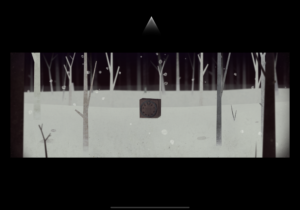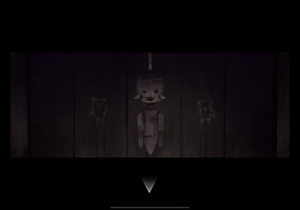For this week’s mystery critical play, I played Year Walk on iPad. Year Walk is a mobile game (iPhone, iPad, only iOS) made in 2013 by the game studio Simogo. The game lists that it is for 12+, however most of the imagery is quite dark and may be better suited for a 17+ audience. Year Walk is a first person adventure game that leverages both 2D and 3D design elements as the player explores a Swedish wood and encounters supernatural creatures.

This game leverages an eerie mood and mysterious tone that is immediately captivating. Ominous music plays during the initial crawl that provides a quick narrative vehicle to bring players into the world. Further, the drawn animations look incredibly twisted and the mechanic of only being able to move forward/backwards and left/right was a very effective gameplay mechanic for creating this mood. Despite being in the first person perspective, I was never able to fully ground myself in my surroundings (as you normally may in a more traditional first person POV) and the limited agency physically and in perspective worked incredibly well. Lastly, the snowstorm, black/white color, and muted visual landscape captured this mood as well.
Types of Fun and Objective:
This game focuses on promoting fun through Narrative, Discovery/Exploration, and some Challenge (via mystery).
Narrative: the reduced mechanics/conflict/etc make this game primarily a game of plot discovery. Unlike an open world game with side-quests, fighting, etc. this game is built around uncovering the plot. The gameplay is simply a vehicle for uncovering the plot.
Exploration: the game involves exploring this unfamiliar, fictional world packed with mysterious symbols, riddles, and eerie houses/figures. By having a relatively small world that is heavily interconnected the game encourages the players to become familiar with the world and quickly traverse it.
Objective: use the limited moving functionality to explore the forest around you. Throughout the game, the forest progressively changes. The mechanic of interacting with other characters for more information to progress the narrative forward, the introduction of the box early into the game, and nested world forces you to explore throughout the game.
These objectives are enforced by the limited bounds of the game. Although exploring the world is the primary focus of the game, it is strictly not an open world. There are hard left/right boundaries on every “level” you move through during the game. Each level is clearly defined with 1-2 intractable items/paths forwards.

Narrative Loops/Gameplay
Thinking about Year Walk in terms of narrative loops, we see that there are many embedded narratives. At first, we get very limited information on our world via the scrolling introduction speech. As we progressively interact with more characters, we receive more information about the Year Walk, who our identity is as the protagonist, etc. I was never able to open the box (which I assume is a late-game development), but I assume that it contains essential information. In that sense, the embedded narrative consistently informs us (via the box) that for however much information we know about the Year Walk, the dangers, etc–there is always more information to uncover.
Further, thinking about the gameplay in terms of cycles:
- Loop 1: We start the game and there is a gameplay loop of learning how the mechanic of moving is executed. It takes about 5 minutes to understand the layout of the world. Specifically: how far the world extends in various directions, how “nested” each destination is from another, and how to quickly move forward.
- Return back to chest/be reminded of the chest as an end goal
- Loop 2: Make it to the Windmill then return home. This opens up the second discovery loop as the world expands much further and we gain access to more land.
- Return back to chest/be reminded of the chest as an end goal
- Loop 3-10: I imagine that this game is a series of discovering all the relative information that is possible on the map and then gain access to more of the map. This introduces an exploration loop that continues compounding.
This works incredibly well because our home (the literal house) is placed strategically right next to the chest, a constant reminder of what is left to be discovered/found out.



